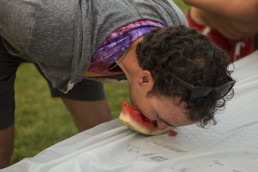Adult Orthodontics: 8 Tips for Surviving Braces as a Grown-Up
From the eating restrictions to the cosmetic appearance, getting braces as an adult can be a difficult decision to make. However, we strive to make adult orthodontics as simple as possible for all our grown-up patients, and promise the resulting healthy and glowing smile will be worth it in the end.
Below are eight tips for surviving adult orthodontics.
- You will most likely feel some discomfort during the first week of having braces. To find relief, use a heating pad or warm washcloth to ease the soreness in your jaw. We will also provide you with wax to put on your metal braces to lessen the discomfort on your cheeks.
- Eat soft foods the first few days with your new braces — think scrambled eggs, oatmeal, pasta, smoothies, and soups. Also, cut your food into small pieces to avoid discomfort or food getting stuck in your braces.
- Avoid certain foods. Stay away from sticky and chewy foods all together, as they can easily get stuck in your braces. Hard foods such as candies and apples often loosen the brackets and break wires. Foods that are high in starch and sugar can cause plaque build-up around your brackets, which leads to cavities, gum disease and stained teeth.
- Create a cleaning kit to always have with you. Include a toothbrush, toothpaste, floss, mouthwash, wax and lip balm in your kit. Whenever you have an important meeting, a special date night or happy hour with friends, you’ll be prepared to clean your teeth and braces anywhere you go.
- Try to avoid coffee and other dark-colored drinks, especially if you have ceramic brackets or Invisalign, as they could stain your braces and teeth.
- Clean your teeth frequently and thoroughly. We strongly recommend brushing your teeth after every meal (that’s where the cleaning kit comes in handy). When food particles get stuck in your braces, this increases the chance for cavities. Additionally, it’s more important than ever before to floss at least once a day in between your braces and under the wires.
- Wear a mouthguard if you play intramural sports, or participate in group fitness classes, in order to protect your teeth and braces. We will happily provide one that will comfortably fit over your brackets and wires. Just ask!
- Know when to call your orthodontist. If you start feeling severe pain, a broken wire or a loose band, call your orthodontist and schedule an emergency appointment. If we can’t get you in right away, you can use a pair of fingernail clippers (that have been washed and sterilized) to remove the pointy part of the wire. Then cover it with wax until you’re able to schedule an appointment.
Ultimately, it’s important to go to your follow-up appointments, in order to adjust your braces regularly and stay on schedule. Remember, you aren’t going to have braces for the rest of your life! If you’re like most of our adult patients, you’ll like be in braces for 12-24 months. Trust us, your new smile will be worth every moment.
If you’re interested in learning more about the process of getting adult orthodontics, don’t hesitate to reach out or schedule a complimentary initial consultation. We look forward to meeting you!
Ready to schedule a free consultation?
Why You May Need Braces for Your Overall Oral Health
You may think you need braces simply to straighten crooked teeth. And, in part, that’s true. It is important to identify symptoms with your teeth early on to ensure the straightest and healthiest smile possible. In fact, we recommend children coming in for a consultation by seven years old, so we can determine if any action is needed immediately, or in the future.
But orthodontic issues can also have a negative impact on your overall oral health if left unaided. Here are five additional reasons why you may need braces.
The 3 Types of Braces we Offer for Teens
1. Overbite
In a perfect world, there should only be a millimeter or two of an overlap between your top teeth and bottom teeth. An overbite occurs if your top teeth land too far ahead of your bottom teeth. If you don’t correct an overbite with braces, you may experience clenching that results in an aching jaw or grinding teeth at night. Your top teeth are also much more prone to trauma or injury with an overbite. Fixing an overbite may result in your face looking different as a result (in a good way!), because it changes the shape of your smile.
2. Underbite
An underbite is the opposite of an overbite, meaning the bottom teeth protrude farther out than the top teeth. It may lead to aches and pains in your jaw, imbalanced facial appearance, and difficulty biting and chewing. Correcting an underbite can also change your appearance, as it changes the shape of your smile and jaw.
3. Crossbite
A crossbite, which occurs when your back teeth are misaligned, can cause wear and tear on your teeth. Sometimes, it can also lead to bone loss or gum disease.
4. Crowded Teeth
Crowded teeth are the most common reason children need orthodontic treatment. Crowding means there isn’t enough room in your mouth for all of your teeth. Your smile may look straight in the front, but your back teeth are overcrowded. This can result in crooked teeth that are almost impossible to clean, creating a buildup of plaque and increased risk of gum disease and bone loss. Correcting crowded teeth makes it easier to floss, brush and maintain good oral health.
5. Cosmetic Reasons
You may not be experiencing any of the above issues, but you do still want a straighter smile. Braces can certainly help with that! Straightening your teeth is good for your oral health, no matter the reason. In fact, braces will set you up with a healthy smile for the rest of your life and that can help sustain your overall health.
Are you or your child currently experiencing any of the issues we listed above? If so — or if you are unsure — we’d encourage you to schedule a free consultation to see if you need braces. We can take a look and make a recommendation. Orthodontic treatment not only straightens teeth, but helps avoid future oral pain, prevent health issues, and reduce the risk of cavities and gum disease. We look forward to hearing from you!
Ready to schedule a free consultation?
What You Need to Know When Looking for a Children's Orthodontist
At Gorman & Bunch Orthodontics, we believe that every child should receive an orthodontic evaluation by age seven — unless an orthodontic problem appears before then. The American Association of Orthodontists recommends the same. And so it’s imperative that you find a quality children’s orthodontist in your area to check your kids’ teeth.
Why do we suggest this? Orthodontic treatment for kids during their growth stages allows us to achieve results that may not be possible once face and jaw bones have fully developed. And this early evaluation helps us to determine the best time to begin any necessary treatment and permits our orthodontic team to watch growth patterns as your child develops, allowing early detection and timely treatment.
Do you need an orthodontist or a dentist?
As orthodontic techniques become more advanced, multi-phase treatment plans have become more popular. These plans are broken up into “Phase 1” and “Phase 2” and are tailored to each individual patient.
Phase One and the Types of Orthodontic Treatment for Kids
The ideal candidates for Phase 1 of orthodontic treatment are young patients whose permanent teeth have not all come in yet, or whose jaws are still growing. During this growth period, orthodontic treatment can be more effective, and less invasive.
The goals of “Phase 1” treatment are to:
- Gain proper width of the upper and lower jaws.
- Create room for crowded teeth to come in.
- Align the jaws to allow proper growth.
- Reduce the risk of trauma to protruding teeth.
- Hold space for permanent teeth that need to come in.
- Reduce the need for tooth removal.
- Reduce treatment time with braces.
- Minimize the need for surgical treatment with certain growth patterns.
To begin Phase 1 treatment, our team will make orthodontic records in order to determine your unique treatment plan. These records include digital models of your teeth, X-rays, and photographs. This information helps us determine the type of orthodontic appliance needed, the duration of treatment time needed, and the frequency of visits to the orthodontist.
Phase Two and the Potential of Braces for Your Kids
A successful Phase 1 treatment creates room for permanent teeth to find their path way in, so they are not impacted or severely displaced during the process.
Between Phase 1 and Phase 2 of orthodontic treatment, your permanent teeth will be left alone as they continue to grow and erupt. We allow these teeth freedom of movement until fully developed. During this time, we recommend staying in close contact with your children’s orthodontist and scheduling progress calls on a six-month basis.
Once your child’s permanent teeth are ready, we then determine the right orthodontic treatment needed in Phase 2 to move teeth into their optimal positions after Phase 1, such as retainers, braces, or Invisalign, in order to straighten your teeth and achieve the best possible smile.
If you have questions about Phase 1 of orthodontic treatment, or think it may be time to bring your child in for their first appointment, don’t hesitate to reach out. You can schedule an appointment or reach out anytime. We’re happy to help!
Ready to schedule a free consultation?
What's the Best Age to Start Orthodontics?
One of the most common questions we receive is, “What is the best age to go to the orthodontist to straighten your teeth?” And our simple answer to this question: You should seek orthodontic treatment to improve your smile as soon as you have a question about the alignment of your teeth or your bite.
Sometimes, it is extremely obvious, such as when you have trouble biting, speaking or chewing or if your teeth are protruding, crowded or too spaced out. Other times, the misalignment of your teeth may be subtle, including clenching your jaw, grinding your teeth or mouth breathing.
If you find that you or your child are experiencing any of these issues, then we recommend following these guidelines:
Orthodontics for Kids
The American Academy of Orthodontics (AAO) recommends that children should have an orthodontic evaluation by the age of seven, before all of the permanent teeth have erupted. Any treatment needed at this age is referred to as Phase I treatment. We recommend this age for two reasons:
There is a wide disparity in tooth development near the age of seven. This requires an expert to know if your child actually needs orthodontic treatment or if it’s normal developmental growth. An orthodontist can also tell if there is enough room in the mouth to accommodate permanent teeth.
Most conditions are easier to treat the earlier they are caught, when natural growth processes are at their peak. If some of these conditions are left untreated at a young age they may require surgery or permanent tooth extractions later in life.
However, there are some behaviors that may require a child to see the orthodontic earlier than the age of seven. These include early or late loss of baby teeth, thumb sucking, tongue thrusting, and mouth breathing. If you notice these behaviors in your child, we strongly recommend making an appointment with an orthodontist.
Do you need a dentist or an orthodontist to straighten your teeth?
Teenage Orthodontics
Phase II of orthodontic treatment is for teens who received Phase I already or didn’t require Phase 1 treatment and have most of their permanent teeth. The goal of this phase is to ideally position all of the permanent teeth in order to maximize appearance and function.
Also, Invisalign Teen offers an alternative to braces for teens — nearly invisible aligners — and we’re the number one local Invisalign provider.
Orthodontics for Adults
According to the AAO, one in five orthodontic patients is an adult. The growing number of options for braces, including Invisalign, makes orthodontic treatment for adults more popular. Properly aligned teeth are important at any age, not just for appearance but also for health. Well-aligned teeth are easier to clean and less susceptible to abnormal wear on the enamel. Furthermore, a better bite allows you to eat better and speak more clearly, maintaining an overall healthier smile.
If you’re still unsure of when to schedule your first orthodontic treatment, reach out to us. We’d love to be your Invisalign specialist. But at the very least, we’d be happy to share what we believe to be the best solution to get a straighter smile based on your individual situation.
Ready to schedule a free consultation?
How to Face the Holidays in Braces
Tis the season for giving gifts, sipping hot chocolate and going on holiday vacations. We know vacations can be tough with braces, so we put together a list of tips for making your holiday with braces a little easier:
1. Pack Orthodontic Care Essentials
- Proxabrushes (Christmas tree-shaped brush for cleaning behind wires)
- Travel toothbrush
- A water bottle or a mini bottle of mouth rinse
- Orthodontic wax to help with discomfort from protruding wires
- A small mirror for examining any possible issues in your mouth
Orthodontic wax is especially important on vacation, in case of any discomfort you may experience. It’s also important to travel with a small mirror, so you can easily check out any issues you may be having. We know you may be indulging on holiday sweets this time of year, so make sure you don’t skimp on your oral hygiene.
Why You May Need Braces for Your Overall Oral Health
2. Avoid Some (Not All) Holiday Foods
To protect your braces, brackets, bands and arch wires, avoid chewing snacks that are hard, sticky, crunchy or chewy. This list includes:
- Apples, pears, and other whole fruits (cut fruit into wedges before consuming)
- Popcorn and nuts
- Bagels and hard rolls
- Corn on the cob
- Hard caramel or peanut candies
- Hard cookies or pretzels
- All varieties of nuts, including peanuts, almonds, and cashews.
You may be tempted with a lot of different treats this time of year, so we hope this list serves as a helpful reminder for what you should avoid. However, there are still many holiday indulgences you can enjoy, such as turkey or ham, mashed potatoes, stuffing, and soft rolls. And if your sweet tooth is calling, stick to soft chocolates, pumpkin pie, peppermint patties, peanut butter cups and other snacks that will melt in your mouth.
3. Step up Your Brushing and Flossing Game
Carefully brush around all of your brackets and wires multiple times per day. Focus on the places where your teeth meet your hums and where each bracket attaches to your teeth, as these are the places that collect the most food and bacteria.
4. Look Up Orthodontist Information in Your Travel Area
Do some research on orthodontists near your holiday destination and have their phone numbers on hand in case something goes wrong. Being prepared will give you peace of mind throughout your vacation. Most orthodontists will be happy to lend a helping hand and help you relieve any pain or discomfort you may experience.
If you do happen to damage your braces while on vacation, don’t hesitate to give us a call. We can talk you through most potential issues, or let you know if you should contact a local orthodontist to take a look. Either way, we’ll want to see you right away upon your return, as it’s important to get your braces fixed in a timely manner.
You’ve worked hard to maintain healthy braces and get a straighter smile, don’t let a different routine over the holidays set you back. Let us know if you have any questions, and enjoy your vacation!
Ready to schedule a free consultation?
Continuing to Improve Your Smile With Retainers
During the Retainer Phase — also known as The Retention Phase — we remove your dental braces and any other orthodontic devices used to correctly align your teeth. At that point, you’ll be free of bands and brackets or any Invisalign attachments. You can eat whatever you want and enjoy the feeling of smooth, clean teeth.
However, keep in mind that you aren’t quite done with your orthodontic treatment yet.
Next up, our orthodontic team will create a custom retainer — typically the day you get your appliances removed — that will continue to straighten your teeth, improve your smile, and ensure that your teeth don’t shift back to their original positions. Here’s what to expect during the retainer phase:
Three Types of Retainers
The most common type of retainer is called the “Hawley” (or loop) retainer — a thin, tongue-shaped piece molded to fit your mouth, using a wire to hold your teeth in position. This type of retainer is simple, durable and can be easily taken out and put back in, making it a removable aligner.
Another popular style is a clear style (or “hard cast”) similar to transparent braces or Invisalign removable aligners. These retainers are custom-made of thin plastic. The main advantage of this style is that they are invisible and easy to remove. However, in cases where an expander or a quad was required, they do not hold the newly gained width as effectively as a loop retainer.
The last option is a fixed retainer, which is a popular choice for the lower teeth. These retainers are not removable, but they are also not visible. A wire is bonded to the backside of the lower canine teeth and may remain in your mouth indefinitely. We recommend this type of retainer when you have a high risk of your teeth reverting back to their pre-braces position.
Your Heart Says Thank you for Your Healthy, Straight Teeth
Adjusting to Your Retainer
Retainers are very easy to adjust to, and you won’t even notice them after a couple of weeks. It may be a little harder to talk at first, but that shouldn’t last long. The hardest part will be to remember to take your retainers out when eating or brushing your teeth – but then putting them back in as soon as you’re done. We have had many patients call us because they accidentally threw away their retainer in a napkin after lunch.
Initially, we recommend wearing your retainer 24/7 for the first ten weeks. After that period of time, we typically transition you into only wearing your retainer at night. If you decrease the frequency in which you wear your retainer, and you feel a tightness when you put it back in, that’s a sign that you waited too long to wear the retainer again. Increase your frequency and see if that feels better. If you’re wearing your retainer every night and still feeling a tightness, give us a call.
Caring for Your Retainer
All retainers need proper cleaning. You can use a toothbrush to clean your retainer, but we recommend using special retainer cleaner (or denture cleaner). Fixed retainers should be cleaned while brushing and flossing. Also, we don’t recommend exposing your retainer to high heat by washing it in hot water, as it could cause the retainer to warp into a new shape.
And lastly, always remember to bring your retainer with you to your orthodontist appointments. Proper use of a retainer will help make the transition from braces to a straighter smile much easier!
As always, give us a call if you have any questions about the retainer phase of your orthodontic treatment. We’ll do anything we can to help you get a straighter smile.
Ready to schedule a free consultation?
Defining Common Orthodontic Terms (M-Z Edition)
In our final attempt to remove any shroud of uncertainty you may feel when visiting our Indianapolis area orthodontic offices, we’re back with a final post in our “Defining Common Orthodontic Terms That Get Lost in Translation” series.
Below you’ll find the M-Z edition—covering everything from “mandibular” to “wax bite.” And if you missed them, check out the full orthodontic vocabulary list in our A-F edition and G-L edition.
– M –
Mandibular
A technical term for anything related to the lower jaw, including the teeth, dental restorations, orthodontic appliances, or facial structures.
Maxillary
A technical term for anything related to the upper jaw, including the teeth, dental restorations, orthodontic appliances, or facial structures.
Malocclusion
Another fancy term for a general misalignment of the teeth or jaws.
Molar
These are the teeth situated toward the back of your mouth. Most people have first, second, and third molars (wisdom teeth).
– O –
Overbite
A top-to-bottom, vertical overlapping of the front teeth. In some situations, the lower teeth may no longer be visible when a patient has a very deep overbite.
Overjet
Described oftentimes as “buck teeth,” overjet refers to how the distance the top teeth extend out away from the lower teeth.
Osteoblast
A cell in the body that creates bone.
Osteoclast
A cell in the body that removes bone.
Did you miss out on terms G-L?
– P –
Palatal Expander
An appliance that makes your upper jaw wider by putting gentle pressure on upper molars each time an adjustment is made.
Panoramic X-Rays
An x-ray taken by a machine that rotates around your head to give your orthodontist a picture of your teeth, jaws, and other vital data.
Phase 1 Treatment
We prescribe Phase 1 Treatment for younger patients to establish the proper “foundation” for future dental and facial development as they become adolescents. In these patients, it is typical to see narrow upper and lower jaws or situations where the back teeth are in a crossbite situation.
Phase 2 Treatment
Here, we implement braces, Invisalign, or other orthodontic appliances after all or most of the adult teeth have erupted (i.e., broken through the gums).
– R –
Records
Usually taken before and after braces, your personal records—including cephalometric and panoramic x-rays, digital photos and study models—help your orthodontist determine what treatment needs to be done.
Removable Retainer
Typically worn after Invisalign treatment or once braces are removed, this appliance fits over your upper and/or lower teeth and holds them in the correct position, while the bone around your teeth adjusts to the new positions of your teeth.
– S –
Separator or Spacer
These are small rubber bands flossed between your back teeth to separate adjacent teeth. We need this space to properly fit bands (i.e., rings) around your teeth (usually on the molars).
– U –
Underbite
In contrast to the overbite, here the lower teeth extend out beyond the upper teeth.
– W –
Wax
A clear wax used to prevent your braces from irritating your lips.
Wax Bite
A procedure to measure how well your teeth come together, which helps the orthodontist relate the upper and lower models of your teeth.
So there you have it. The most common orthodontic terms defined. Did we miss anything? Are there other terms you’ve heard around our office that you’d like to know more about?
Let us know in the comments below, and we hope to see you soon!
Ready to schedule a free consultation?
How We Use Invisalign and Braces to Shift Your Overbite Into a Great Smile
As the name implies, an overbite results when the upper front teeth extend forward and cover the lower front teeth. If you’ve visited any of the Gorman & Bunch Orthodontics offices, you may have heard us refer to it as a malocclusion—orthodontist speak for a misalignment of the teeth and jaws.
It’s a very common condition. In fact, many people don’t even realize they have an overbite until diagnosed by an orthodontist. But it can be a serious condition. If left untreated, overbites can create significant dental problems.
Fortunately, it’s fairly straightforward for us to fix with the use of Invisalign or braces.
How Thumb Sucking Affects Your Child’s Teeth
Reasons for an Overbite
There are two main causes of an overbite:
- Genetics: Overbites are often hereditary, and there’s nothing you can do to avoid them. Either your lower jaw is underdeveloped or your upper jaw is overdeveloped.
- Childhood Tendencies: Sometimes childhood tendencies can create an overbite, such as thumbsucking, prolonged bottlefeeding, chewing your nails, or extended pacifier use. In these cases, we correct your overbite by guiding your jaws back in the right position.
How Orthodontic Treatment Can Fix Your Overbite
Some people may want to treat their overbite for pure esthetic reasons. However, in more extreme cases, overbites may cause health issues, such as speech issues, trauma to the teeth, difficulty chewing, gum damage, jaw pain, and more.
The process for correcting an overbite frequently involves repositioning the lower jaw and teeth to match your upper jaw and teeth. First, we take x-rays, pictures and digital impressions of your teeth to determine the exact positions of your upper and lower jaw. Then, we use one of the following tactics to correct the issue:
- Invisalign: In many cases, we’re able to treat patients with an overbite using Invisalign, a customized set of clear, plastic aligners. These removable aligners fit perfectly to your teeth and allow you to eat almost anything during treatment.
- Braces and Elastics: For those with braces, adding elastics between your top and bottom brackets moves your upper and lower jaw into the right positions. Elastics are typically used in less severe cases of overbites.
- Appliances: For more extreme and rare cases, we may use an appliance—such as a Herbst Appliance—to correct skeletal imbalances where the lower jaw is behind the upper jaw.
- Permanent Tooth Extractions: Sometimes the jaw discrepancy and teeth crowding are more than can be corrected with Invisalign or braces alone. In these more severe cases, we selectively extract permanent teeth (premolars) to create space to correct the overbite and relieve crowding.
- Jaw Surgery: Sometimes, the issues with jaw discrepancy lie in the bones. In these severe cases, a highly skilled oral surgeon works in unison with our doctors to create a comprehensive treatment plan to align the teeth and surgically correct the jaws, leading to an ideal esthetic and functional result.
While it is possible to be treated for an overbite at any age, the earlier we can detect the issue—ideally during jaw development—the better. In many cases, early treatment can help avoid more complicated treatment down the road. Nevertheless, please don’t hesitate to reach out at any age if you have questions regarding an overbite. We’re happy to help!
Ready to schedule a free consultation?
Friends of G&B Orthodontics: Fishers Pediatric Dentistry
We’re so grateful for our friends in the dental community, as they prepare and sustain good oral health for many of our patients. Together, we’re able to create great looking smiles across Central Indiana.
In this post, we turn the spotlight on one particular dental practice and showcase their unique approach to serving families in Indianapolis, Carmel, Fishers, Noblesville, Westfield, Zionsville, Kokomo, Marion, Wabash, and beyond.
Today we’re talking with Courtney Bradshaw, LDH, Practice Ambassador at Fishers Pediatric Dentistry (9126 Technology Lane, Suite 100, Fishers, Indiana). Visit FishersPediatric.com or give them a call at 317-598-9898 for more information.
Need an Orthodontist or a Dentist?
Can you give a quick overview of your dental practice?
Fishers Pediatric Dentistry was founded in 1996 by Dr. Ana Vázquez and has become a well-respected pediatric dental office in Central Indiana, specializing in the treatment of infants, children, adolescents, and individuals with special healthcare needs. In 2016, Dr. Misti Pratt joined Dr. Ana as a proud partner and co-owner of Fishers Pediatric Dentistry. Together, Dr. Ana and Dr. Misti share a common bond: a genuine passion for children and a vision for creating a unique dental experience, while providing the highest level of quality care.
Stepping inside Fishers Pediatric Dentistry is like wandering through a tropical resort. Our office features a tropical, beach-themed atmosphere creating the ultimate dental experience from the moment you step foot in the door. With 17 dental chairs in private, semi-private, or open-bay setting, our office can accommodate the needs of every child.

What makes your practice unique?
At Fishers Pediatric Dentistry, our mission is to deliver a dental experience full of compassion, creativity and charm, laying down a positive foundation for a lifetime of beautiful smiles. From busy toddlers that require an animated appointment to hold their attention to independent teenagers who are curious about options to help boost their confidence and brighten their smile, Fishers Pediatric Dentistry has everyone’s needs in mind. Do you have a child with special needs that will do better in a quiet setting and needs a little more time and guidance to feel comfortable? Fishers Pediatric Dentistry can help.
We understand that getting your child to the dentist is not always easy, so we’re constantly seeking ways to innovate and improve the standard of patient care. In 2016, the office welcomed a new addition to the team—a chairside Therapy Dog named Pearly. Animal assisted therapy is known to provide physical and emotional benefits during stressful situations, such as a trip to the dentist, along with providing a sense of calming and support for those who are nervous. Fishers Pediatric Dentistry strives to provide service excellence for both our patients and their parents. Our entire staff is specially trained to provide positive behavior guidance to ensure that every child receives the ultimate dental experience.
Fishers Pediatric Dentistry also caters to multicultural families. Spanish speaking patients can be assisted by one of our 10 Spanish translating team members. Three of our team members speak Sign Language and one speaks Korean.

What do you love the most about oral care?
Our motto is: One of life’s greatest pleasures…is a child’s smile! The practice’s philosophy is to combine our passion and purpose to transform the dental experience for today’s youth. From creating a fun experience full of laughter and play to providing the highest level of quality care and educating on a level that children can understand, we believe there is nothing more rewarding than making a child smile.
What advice do you give to your patients when choosing an orthodontic practice?
The most important advice that we give is to choose an office that you and your child trust. There are many factors to consider when choosing an orthodontic home, and every household has different needs—be it travel time or traffic, frequency of visits, appointment availability, treatment options, or budget constraints. When it comes to your child’s smile, we recommend choosing the office that you and your child trust the most. Be sure to involve your children when making this decision and ask for their valued input. Although they may have little minds, they can have a big opinion on what feels like home to them.
How did you first get to know Gorman & Bunch Orthodontics?
Pediatric dentistry and orthodontics go hand in hand, and as colleagues we generally know one another from collaborating on treatments of mutual patients, being introduced by another colleague or simply meeting at a convention or lecture. The most memorable moment of growing our professional relationship with Gorman and Bunch Orthodontics was over 10 years ago when Dr. Bunch and his staff came to the office to introduce themselves and share their vision. It was during that personal conversation that personalities connected. Dr. Ana instantly respected his orthodontic savvy and overall practice philosophy. We deeply value our relationship with their entire team and often connect on both professional and personal levels.
Why do you choose to work with us?
The enthusiasm that Dr. Gorman, Dr. Bunch, and Dr. Carly have for changing lives shines through at every encounter. It’s more than just a job. It’s a passion. The quality of care that you provide is evident in the beautiful smiles of our mutual patients. You are driven not only to change the quality of one’s smile, but to change the quality of one’s life. You go above and beyond to make an impact by your willingness to take on the most challenging cases and provide stellar service.

















































































